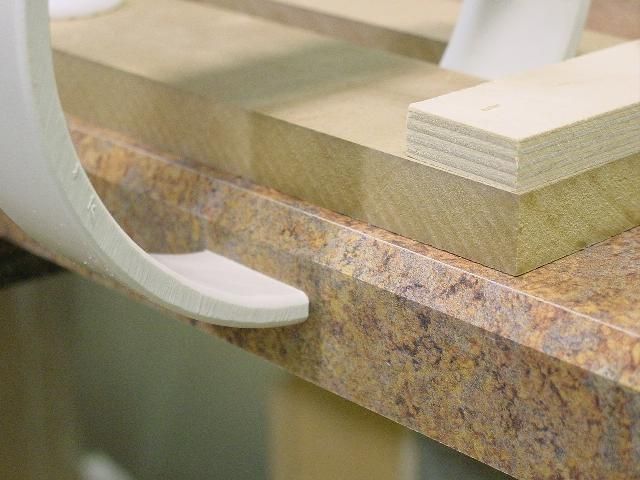Applying Laminate to a Curved Wall
Installers puzzle over how to seam sections of laminate applied to a curved wall as an architectural covering. July 15, 2009
Question
I have to laminate a 41" high radiused wall that is going to require two seams. The wall in question is pinched between two straight walls, so some scribing (this is commercial work) is going to be necessary on both the right and left.
In order to get a good seam I was contemplating scribing and installing the right and left piece, leaving about 2"-3" at each seam side unglued, then cutting the center section about 4"-6" long (also with both seam sides unglued) and installing it with the overlay. My theory is then to go back and cut both pieces simultaneously, remove cutoffs, and hopefully, create a nearly invisible seam.
My question is what type of tool to use for this. Router bits and shears obviously won't work. A good sharp razor with a straight edge is the first inclination, however, I have been known to let a razor wander on occasion. I was wondering about some type of rotary cutting tool (some type of edged wheel on a handle) that might fit the bill here. Any comments or ideas? I am not married to this method - just what pops into my head. Please feel free to enlighten me if there is a better way to do this.
Forum Responses
(Laminate and Solid Surfacing Forum)
From contributor C:
Is it possible to use a piece of trim to cover the ends of the straight pieces? That way you would have tight seams on the radius part, and you wouldn't have to worry about fitting the straight pieces. I would do the radius first and then fit the other pieces to that.
From contributor J:
Sounds like a challenging project. I hate putting laminate on anything vertically. Elevator walls are my favorite headache! Any chance you could pull that vertical surface out and stick the laminate flat? If not, I'd figure out how many pieces are needed, plan my seams, and do my mirror cuts flat on a table. I'd mark them so they can be easily realigned. I'd leave the outside piece about 1/4" long and scribe it to the wall. An even better choice is covering with a piece of trim of some type.
I don't think the process you describe in your post will work very well. I've never tried a mirror cut with a razor knife but I don't think I could do it cleanly enough to go through two sheets of laminate. The other option would be a laminate trimmer and that will leave kerfs on both sides and a piece of laminate that's too small.
You may find that vertical grade is too flimsy for what you're attempting. Standard grade has more 'body' and will hold itself up and cooperate better as you try to stick it.
From contributor M:
For your sake I hope the laminate you're using is woodgrain. It's much easier to hide a seam with woodgrain laminate. I have some experience doing this type of work. I worked for a commercial shop for several years and we did a lot of reception walls. I would not try to fit a piece in the middle of the wall. You have to scribe two sides to walls already. Why add any more fitting than is absolutely necessary. Also against a wall there are additional options such as trim or caulking. You didn't mention if this wall is being built and installed by you or only laminated by you. If you're building the wall I would cover the whole thing before installation.
From contributor O:
Does the wall go to the floor, or is there a recessed toe? Also, if the counter is not on the wall yet and you can run a trim router completely through the seam from top to bottom then get yourself an underscribe router. Proceed as you were going to, the only difference is you need to put a seam edge on your left and right pieces for the router to trim to before you put them up. Then glue your middle piece leaving 1'' or so overlapping the other seams and trim away. This is provided you can route from top to bottom.
From contributor S:
Put the middle sections in first, and then basically trim and fit from there. Make the outer sections 1/2 long and fit your inner seams first, then measure and cut to length. Hold in place and you might have to shave off 1/32 and keep checking until it is right on. I would also use carpenters glue on the seams, and contact cement everywhere else. Your seams will open up otherwise with the change in temperature. Don't even think about just using a laminate knife, or even laminate scissors. You need the edge to be near perfect to get a good seam.
